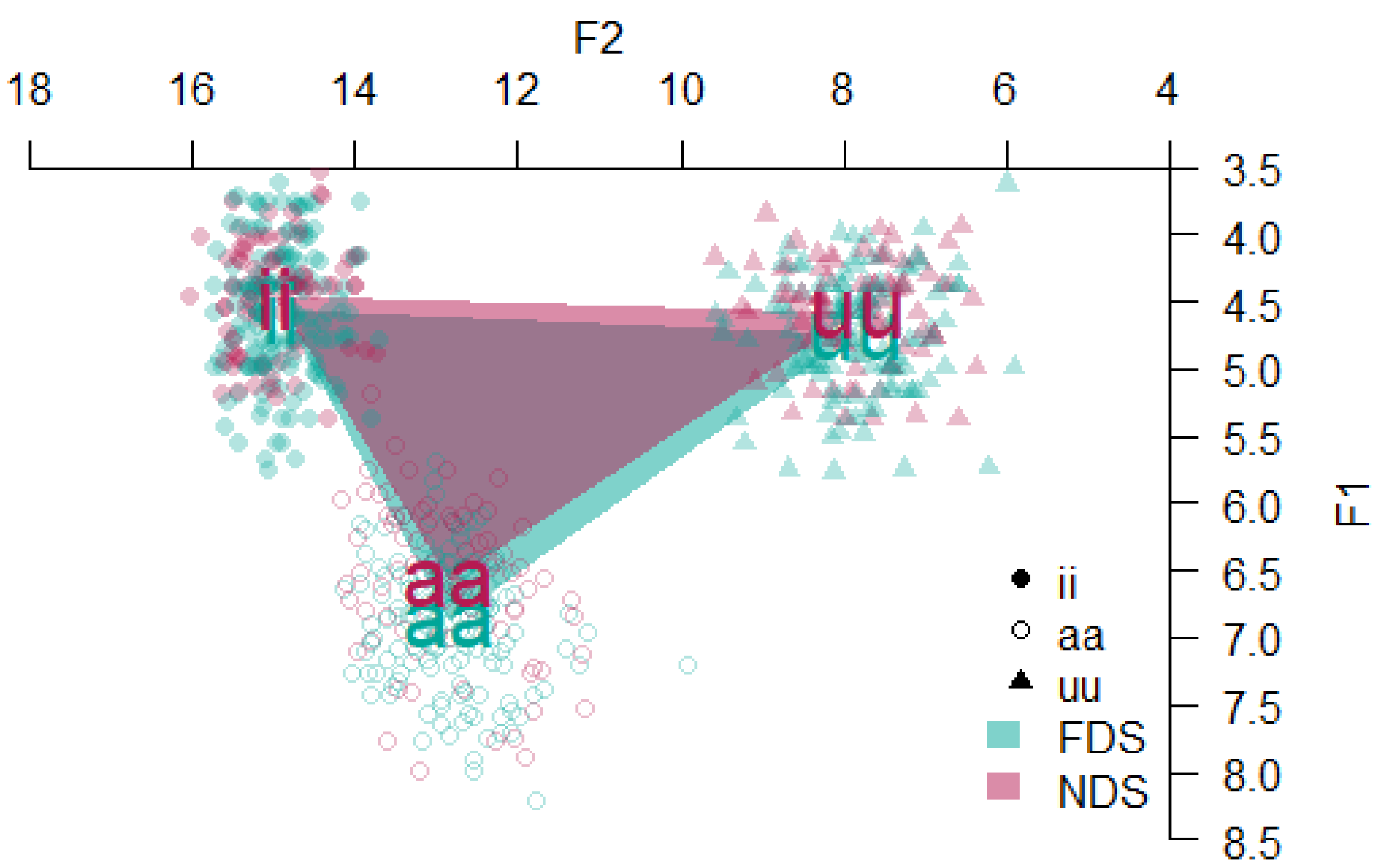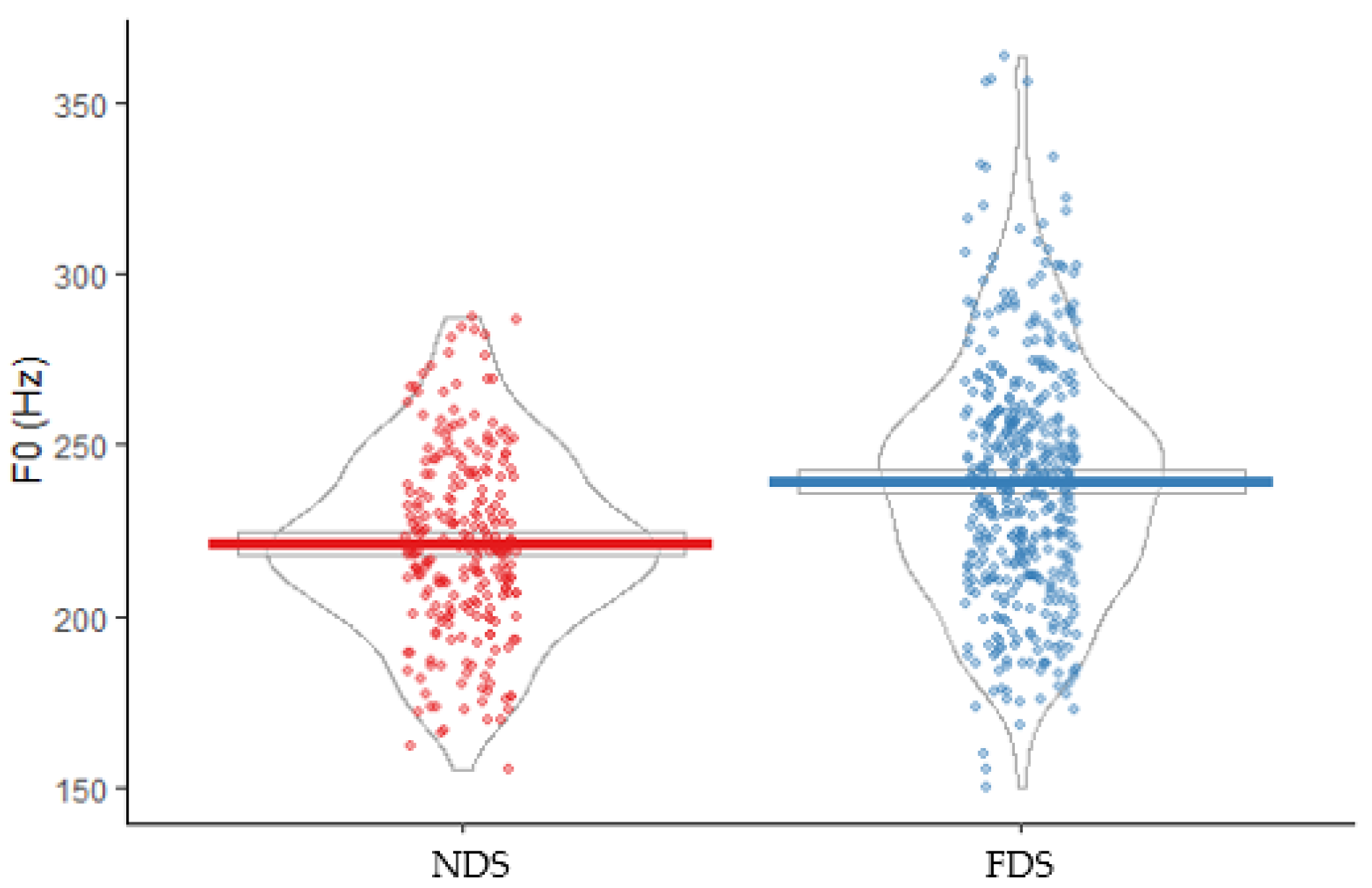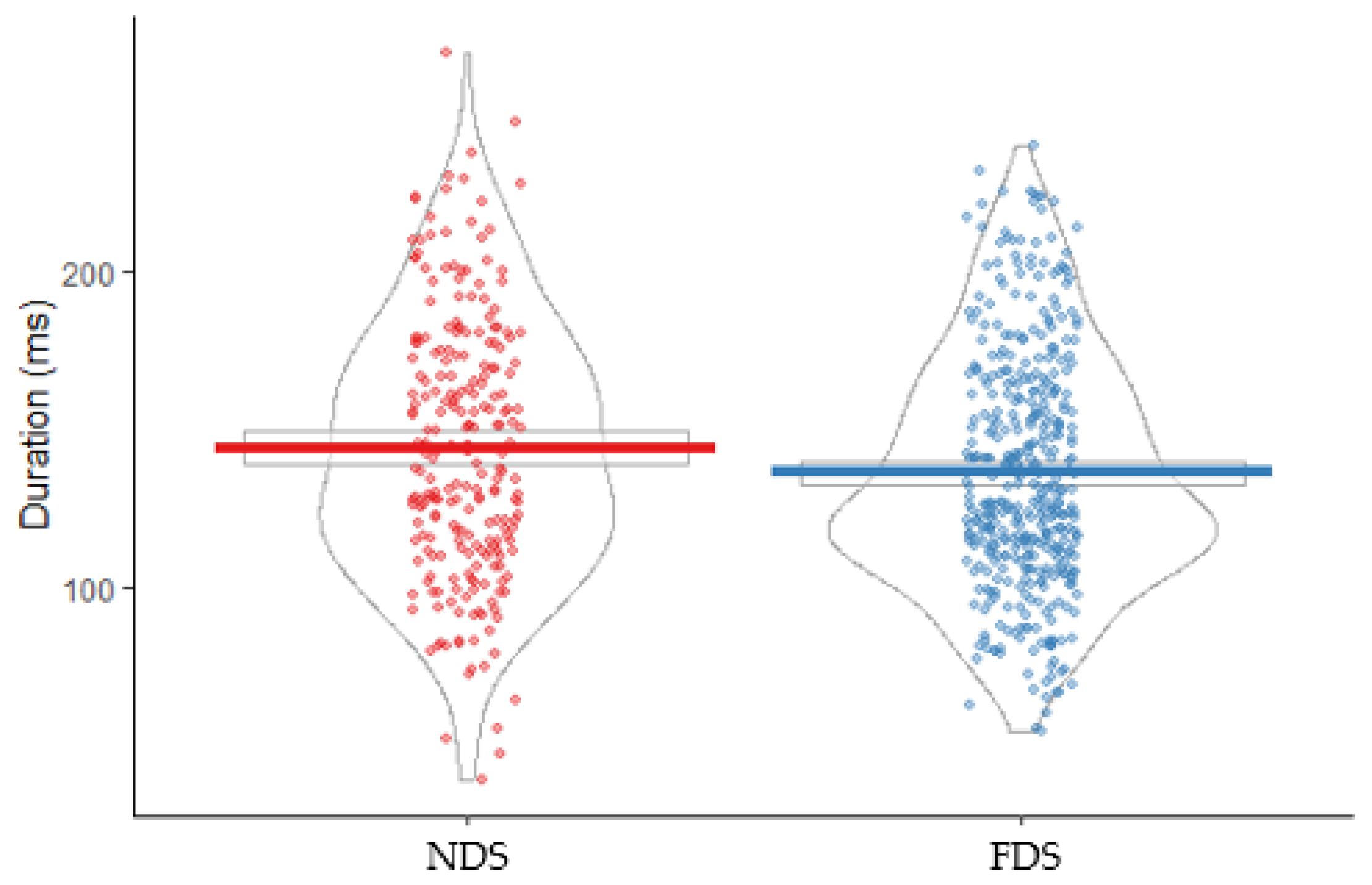The Acoustic Properties of Vowels in Foreigner-Directed Speech: Insights from Speech Directed at Foreign Domestic Helpers †
Abstract
1. Introduction
2. The Acoustic Properties of Vowels in Foreigner-Directed Speech
3. The Present Study
4. Materials and Methods
4.1. Participants
4.2. Method
4.3. Stimuli
4.4. Task Design and Procedures
4.5. Acoustic and Statistical Analysis
5. Results
5.1. Vowel Space
5.2. Formant Frequencies (F1 and F2)
5.3. Prosodic and Temporal Features (f0, Intensity, and Duration)
6. Discussion and Conclusions
6.1. Vowel Space Area and Formant Frequencies
6.2. Temporal Properties
6.3. Prosodic Properties
6.4. The Role of Foreigners’ Psycholinguistic Factors
Funding
Institutional Review Board Statement
Informed Consent Statement
Data Availability Statement
Conflicts of Interest
Appendix A

| 1 | Intelligibility refers to a foreigner’s ability to recognize individual words spoken by a native speaker, focusing on pronunciation clarity. In contrast, comprehensibility refers to a foreigner’s ability to understand the overall message and meaning of the native speaker’s speech. |
| 2 | The animal objects used in the data collection task represented toys. |
References
- Adriaans, F., & Swingley, D. (2017). Prosodic exaggeration within infant-directed speech: Consequences for vowel learnability. The Journal of the Acoustical Society of America, 141(5), 3070–3078. [Google Scholar] [CrossRef] [PubMed]
- Albin, D., & Echols, C. (1996). Stressed and word-final syllables in infant-directed speech. Infant Behavior and Development, 19(4), 401–418. [Google Scholar] [CrossRef]
- Al-Kendi, A., & Khattab, G. (2019, August 5–9). Acoustic properties of foreigner directed speech. 19th International Congress of Phonetic Sciences, Melbourne, Australia. [Google Scholar]
- Al-Kendi, A., & Khattab, G. (2021). Psycho-social constraints on naturalistic adult second language acquisition. Languages, 6(3), 129. [Google Scholar] [CrossRef]
- Al-Tamimi, J. (2017). Revisiting acoustic correlates of pharyngealization in Jordanian and Moroccan Arabic: Implications for formal representations. Laboratory Phonology: Journal of the Association for Laboratory Phonology, 8(1), 1–40. [Google Scholar] [CrossRef]
- Baker, R., & Hazan, V. (2011). DiapixUK: Task materials for the elicitation of multiple spontaneous speech dialogs. Behavior Research Methods, 43(3), 761–770. [Google Scholar] [CrossRef]
- Barr, D., Levy, R., Scheepers, C., & Tily, H. J. (2013). Random effects structure for confirmatory hypothesis testing: Keep it maximal. Journal of Memory and Language, 68(3), 255–278. [Google Scholar] [CrossRef] [PubMed]
- Beebe, L. M., & Giles, H. (1984). Speech-accommodation theories: A discussion in terms of second-language acquisition. Language Learning, 34(4), 5–32. [Google Scholar] [CrossRef]
- Biersack, S., Kempe, V., & Knapton, L. (2005, September 4–8). Fine-tuning speech registers: A comparison of the prosodic features of child-directed and foreigner-directed speech. Ninth European Conference on Speech Communication and Technology, Lisbon, Portugal. [Google Scholar]
- Bobb, S. C., Mello, K., Turco, E., Lemes, L., Fernandez, E., & Rothermich, K. (2019). Second language learners’ listener impressions of foreigner-directed speech. Journal of Speech, Language, and Hearing Research, 62(9), 3135–3148. [Google Scholar] [CrossRef]
- Boersma, P., & Weenink, D. (2009). Praat: Doing phonetics by computer. Available online: http://www.fon.hum.uva.nl/praat/ (accessed on 30 September 2016).
- Bradlow, A., & Bent, T. (2002). The clear speech effect for non-native listeners. The Journal of the Acoustical Society of America, 112(1), 272–284. [Google Scholar] [CrossRef]
- Bradlow, A. R., Kraus, N., & Hayes, E. (2003). Speaking clearly for children with learning disabilities. Journal of Speech, Language, and Hearing Research 46, 80–97. [Google Scholar] [CrossRef]
- Broesch, T., & Bryant, G. (2015). Prosody in infant-directed speech is similar across western and traditional cultures. Journal of Cognition and Development, 16(1), 31–43. [Google Scholar] [CrossRef]
- Butler, S., O’Sullivan, L., Shah, B., & Berthier, N. (2014). Preference for infant-directed speech in preterm infants. Infant Behavior and Development, 37(4), 505–511. [Google Scholar] [CrossRef]
- Cooper, R. P., Abraham, J., Berman, S., & Staska, M. (1997). The development of infants’ preference for motherese. Infant Behavior and Development, 20(4), 477–488. [Google Scholar] [CrossRef]
- Cooper, R. P., & Aslin, R. (1990). Preference for infant-directed speech in the first month after birth. Child Development, 61(5), 1584–1595. [Google Scholar] [CrossRef]
- Coupland, N., & Giles, H. (1988). Introduction: The communicative contexts of accommodation. Language & Communication, 8(3–4), 175–182. [Google Scholar] [CrossRef]
- Ellis, R. (1985). Understanding second language acquisition. Oxford University Press. [Google Scholar]
- Ferguson, S., & Kewley-Port, D. (2002). Vowel intelligibility in clear and conversational speech for normal-hearing and hearing-impaired listeners. The Journal of the Acoustical Society of America, 112(1), 259–271. [Google Scholar] [CrossRef]
- Fernald, A., & Kuhl, P. (1987). Acoustic determinants of infant preference for motherese speech. Infant Behavior and Development, 10(3), 279–293. [Google Scholar] [CrossRef]
- Fernald, A., & Mazzie, C. (1991). Prosody and focus in speech to infants and adults. Developmental Psychology, 27(2), 209–221. [Google Scholar] [CrossRef]
- Fernald, A., & Simon, T. (1984). Expanded intonation contours in mothers’ speech to newborns. Developmental Psychology, 20(1), 104–113. [Google Scholar] [CrossRef]
- Freed, B. F. (1981). Foreign talk: A study of speech adjustments made by native speakers for nonnative speakers. Studies in Second Language Acquisition, 3(1), 19–39. [Google Scholar]
- Giles, H., & Gasiorek, J. (2013). Parameters of nonaccommodation: Refining and elaborating communication accommodation theory. In H. Giles (Ed.), Social Cognition and communication (pp. 155–172). Psychology Press. [Google Scholar]
- Giles, H., & Ogay, T. (2007). Communication accommodation theory. In B. B. Whaley, & W. Samter (Eds.), Explaining communication: Contemporary theories and exemplars (pp. 319–337). Routledge. [Google Scholar]
- Gleitman, L., & Wanner, E. (1982). Language acquisition: The state of the art. Cambridge University Press. [Google Scholar]
- Han, M., De Jong, N. H., & Kager, R. (2022). Prosodic input and children’s word learning in infant-and adult-directed speech. Infant Behavior and Development, 68, 101728. [Google Scholar] [CrossRef] [PubMed]
- Harder, J. (1980). Foreigner talk: A critical review of the literature. International Journal of the Sociology of Language, 25, 9–28. [Google Scholar]
- Hatch, E. (1983). Simplified input and second language acquisition. In Pidginization and creolization as language acquisition (pp. 64–86). Newbury House Pub. [Google Scholar]
- Hatch, E., Sapira, R., & Gough, J. (1978). Foreigner talk discousre. Working Papers in English as a Second Language. Los Angeles. [Google Scholar] [CrossRef]
- Hazan, V., Uther, M., & Granlund, S. (2015, August 10–14). How does foreigner-directed speech differ from other forms of listener-directed clear speaking styles? 18th International Congress of Phonetic Sciences, Glasgow, UK. [Google Scholar]
- Janicki, M. (1986). Foreigner talk: A study of conversational adjustment in native-nonnative interactions. Language in Society, 15(3), 329–352. [Google Scholar]
- Kangatharan, J. (2015). The role of vowel hyperarticulation in clear speech to foreigners and infants [Doctoral dissertation, Brunel University London]. [Google Scholar]
- Kangatharan, J., Uther, M., & Gobet, F. (2022). The effect of hyperarticulation on speech comprehension under adverse listening conditions. Psychological Research, 86(5), 1535–1546. [Google Scholar] [CrossRef] [PubMed]
- Knoll, M., & Costall, A. (2015). Characterizing F(0) contour shape in infant-and foreigner-directed speech. Speech Communication, 66, 231–243. [Google Scholar] [CrossRef]
- Knoll, M., & Scharrer, L. (2007, August 27–31). Acoustic and affective comparisons of natural and imaginary infant-foreigner and adult-directed speech. Eighth Annual Conference of the International Speech Communication Association, Antwerp, Belgium. [Google Scholar]
- Knoll, M., Scharrer, L., & Costall, A. (2009). Are actresses better simulators than female students? The effects of simulation on prosodic modifications of infant-and foreigner-directed speech. Speech Communication, 51(3), 296–305. [Google Scholar] [CrossRef][Green Version]
- Kuhl, P., Andruski, J., Chistovich, I., Chistovich, L., Kozhevnikova, E., Ryskina, V., Stolyarova, E., Sundberg, U., & Lacerda, F. (1997). Cross-language analysis of phonetic units in language addressed to infants. Science, 277(5326), 684–686. [Google Scholar] [CrossRef]
- Kuznetsova, A., Brockhoff, P., & Christensen, R. (2017). lmerTest package: Tests in linear mixed effects Models. Journal of Statistical Software, 82(13), 1–26. [Google Scholar] [CrossRef]
- Kühnert, B., & Antolík, T. K. (2017). Patterns of articulation rate variation in English/French tandem interactions. In M. Zampini (Ed.), Pronunciation of English by Speakers of Other Languages. Cambridge University Press. [Google Scholar]
- Lehiste, I. (1976). Suprasegmental features of speech. In N. Lass (Ed.), Contemporary issues in experimental phonetics (pp. 225–239). Academic Press. [Google Scholar]
- Liénard, J., & Di Benedetto, M. (1999). Effect of vocal effort on spectral properties of vowels. The Journal of the Acoustical Society of America, 106(1), 411–422. [Google Scholar] [CrossRef]
- Lindblom, B. (1990). Explaining phonetic variation: A sketch of the H&H theory. In W. Hardcastle, & A. Marchal (Eds.), Speech Production and Speech Modelling (pp. 403–439). Springer. [Google Scholar]
- Long, M. H. (1983). Native speaker/non-native speaker conversation and the negotiation of comprehensible input. Applied Linguistics, 4(2), 126–141. [Google Scholar] [CrossRef]
- McCloy, D. (2016). PhonR: Tools for phoneticians and phonologists (R Package Version 1.0-7). R Core Team. [Google Scholar]
- Miyazawa, K., Shinya, T., Martin, A., Kikuchi, H., & Mazuka, R. (2017). Vowels in infant-directed speech: More breathy and more variable, but not clearer. Cognition, 166, 84–93. [Google Scholar] [CrossRef] [PubMed]
- Monsen, R., Engebretson, A., & Vemula, N. (1978). Indirect Assessment of the Contribution of Subglottal Air Pressure and Vocal-fold Tension to Changes of Fundamental Frequency in English. The Journal of the Acoustical Society of America, 64(1), 65–80. [Google Scholar] [CrossRef]
- Moyer, A. (2004). Age, accent, and experience in second language acquisition: An integrated approach to critical period inquiry. Multilingual Matters. [Google Scholar]
- Munro, M. J., & Derwing, T. M. (1999). Foreign accent, comprehensibility, and intelligibility in the speech of second language learners. Language Learning, 49, 285–310. [Google Scholar] [CrossRef]
- Narayanan, S., & Wang, D. (2005, March 23). Speech rate estimation via temporal correlation and selected sub-band correlation. International Conference on Acoustics, Speech, and Signal Processing, Philadelphia, PA, USA. [Google Scholar]
- Piazza, G., Kalashnikova, M., & Martin, C. D. (2023). Phonetic accommodation in non-native directed speech supports L2 word learning and pronunciation. Scientific Reports, 13(1), 21282. [Google Scholar] [CrossRef]
- Piazza, G., Martin, C. D., & Kalashnikova, M. (2022). The acoustic features and didactic function of foreigner-directed speech: A scoping review. Journal of Speech, Language, and Hearing Research, 65(8), 2896–2918. [Google Scholar] [CrossRef]
- Picheny, M., Durlach, N., & Braida, L. (1986). Speaking clearly for the hard of hearing II: Acoustic characteristics of clear and conversational speech. Journal of Speech, Language, and Hearing Research, 29(4), 434–446. [Google Scholar] [CrossRef]
- Quigley, J., Nixon, E., & Lawson, S. (2019). Exploring the association of infant receptive language and pitch variability in fathers’ infant-directed speech. Journal of Child Language, 46(4), 800–811. [Google Scholar] [CrossRef]
- R Core Team. (2012). R: A language and environment for statistical computing. R Foundation for Statistical Computing. ISBN 3-900051-07-0. [Google Scholar]
- Rodriguez-Cuadrado, S., Baus, C., & Costa, A. (2018). Foreigner talk through word reduction in native/non-native spoken interactions. Bilingualism: Language and Cognition, 21(2), 419–426. [Google Scholar] [CrossRef]
- Rothermich, K., Harris, H. L., Sewell, K., & Bobb, S. C. (2019). Listener impressions of foreigner-directed speech: A systematic review. Speech Communication, 112, 22–29. [Google Scholar] [CrossRef]
- Scarborough, R., Dmitrieva, O., Hall-Lew, L., Zhao, Y., & Brenier, J. (2007). An acoustic study of real and imagined foreigner-directed speech. Journal of the Acoustical Society of America, 121(5), 3044. [Google Scholar] [CrossRef]
- Scarcella, R. C., & Higa, M. (1982). The influence of first language on the acquisition of a second language sound system. Language Learning, 32(1), 1–28. [Google Scholar]
- Shi, J., Gu, Y., & Vigliocco, G. (2023). Prosodic modulations in child-directed language and their impact on word learning. Developmental Science, 26(4), e13357. [Google Scholar] [CrossRef]
- Smith, R. (2007, August 6-10). Prosodic accommodation by French speakers to non-native interlocutors. In 16th International Congress of Phonetic Sciences (ICPhS XVI). Saarbrücken, Germany. [Google Scholar]
- Suttora, C., Salerni, N., Zanchi, P., Zampini, L., Spinelli, M., & Fasolo, M. (2017). Relationships between structural and acoustic properties of maternal talk and children’s early word recognition. First Language, 37(6), 612–629. [Google Scholar] [CrossRef]
- Tabain, M. (2003). Effects of prosodic boundary on/aC/sequences: Acoustic results. The Journal of the Acoustical Society of America, 113(1), 516–531. [Google Scholar] [CrossRef] [PubMed]
- Tarone, E. (1980). Communication strategies, foreigner talk, and repair in interlanguage. Language Learning, 30(2), 417–431. [Google Scholar] [CrossRef]
- Trainor, L. J., & Desjardins, R. N. (2002). Pitch characteristics of infant-directed speech affect infants’ ability to discriminate vowels. Psychonomic Bulletin & Review, 9(2), 335–340. [Google Scholar]
- Traunmüller, H. (1990). Analytical expressions for the tonotopic sensory scale. The Journal of the Acoustical Society of America, 88(1), 97–100. [Google Scholar] [CrossRef]
- Uther, M., Giannakopoulou, A., & Iverson, P. (2012). Hyperarticulation of vowels enhances phonetic change responses in both native and non-native speakers of English: Evidence from an auditory event-related potential study. Brain Research, 1470, 52–58. [Google Scholar] [CrossRef]
- Uther, M., Knoll, M., & Burnham, D. (2007). Do you speak E-NG-LI-SH? A comparison of foreigner-and infant-directed speech. Speech Communication, 49(1), 2–7. [Google Scholar] [CrossRef]
- Werker, J. F., Pons, F., Dietrich, C., Kajikawa, S., Fais, L., & Amano, S. (2007). Infant-directed speech supports phonetic category learning in English and Japanese. Cognition, 103(1), 147–162. [Google Scholar] [CrossRef] [PubMed]
- Wesche, M. (1994). Input and interaction in second language acquisition. In C. Gallaway, & B. Richards (Eds.), Input and interaction language acquisition (pp. 219–249). Cambridge University Press. [Google Scholar]
- Zuengler, J. (1991). Accommodation in native-nonnative interactions: Going beyond the “what” to the “why” in second-language research. In P. J. Feagin, J. C. Lee, & A. L. X. Rojas (Eds.), Contexts of accommodation: Developments in applied sociolinguistics (pp. 223–244). Oxford University Press. [Google Scholar]







| Group | Mean | Median | SD | Variance |
|---|---|---|---|---|
| FDH | 3.64 | 3 | 2.62 | 6.86 |
| NS | 8.61 | 9 | 1.22 | 1.49 |
| Vowel | Keyword | ||
|---|---|---|---|
| /i:/ | /fi:l/ ‘elephant’2 | /ti:n/ ‘fig’ | /ħali:b/ ‘milk’ |
| /a:/ | /ba:b/ ‘door’ | /ta:g/ ‘crown’ | /kta:b/ ‘book’ |
| /u:/ | /fu:l/ ‘chickpeas’ | /tu:t/ ‘berries’ | /χaru:f/ ‘sheep’ |
| Predictor | Estimate | Std. Error | df | t-Value | Pr (>|t|) |
|---|---|---|---|---|---|
| Intercept | 12.93 | 0.56 | 21.84 | 22.93 | |
| Speech: FDS | 2.67 | 0.12 | 650.36 | 20.9 | <2 × 10−16 *** |
| Predictor | Estimate | Std. Error | df | t-Value | Pr (>|t|) |
|---|---|---|---|---|---|
| Intercept | 14.38 | 2.15 | 21.0006 | 6.66 | |
| Accent rating | 0.2 | 0.59 | 21 | 0.34 | 0.73 |
| LoR | −0.14 | 0.14 | 21.0031 | −1.005 | 0.32 |
| Religion: non-Muslim | 1.23 | 2.06 | 21.0053 | 0.59 | 0.55 |
| Metric | Vowel | Predictor | Estimate | Std. Error | df | t Value | Pr (>|t|) |
|---|---|---|---|---|---|---|---|
| F1 | /i:/ | NDS (Baseline) | 4.43 | 0.07 | 26.53 | 58.17 | |
| FDS | 0.11 | 0.04 | 221.52 | 2.605 | 0.009 ** | ||
| /u:/ | NDS | 4.62 | 0.12 | 3.1003 | 38.38 | ||
| FDS | 0.15 | 0.04 | 188.63 | 3.25 | 0.001 ** | ||
| /a:/ | NDS | 6.59 | 0.09 | 24.35 | 69.99 | ||
| FDS | 0.205 | 0.04 | 213.02 | 4.58 | <0.0001 *** | ||
| F2 | /i:/ | NDS | 15.02 | 0.09 | 11.33 | 154.71 | |
| FDS | −0.08 | 0.04 | 218.76 | −1.77 | 0.07 | ||
| /u:/ | NDS | 7.81 | 0.19 | 4.58 | 40.46 | ||
| FDS | 0.09 | 0.09 | 194.26 | 0.99 | 0.32 |
| Vowel | Model | Df | AIC | BIC | LogLike | Deviance | Chisq | Df | Pr (>Chisq) |
|---|---|---|---|---|---|---|---|---|---|
| /i:/ | Reduced Model | 5 | 201.72 | 219.14 | −95.85 | 191.72 | |||
| Full Model | 6 | 197.06 | 217.97 | −92.53 | 185.06 | 6.65 | 1 | 0.001 ** | |
| /u:/ | Reduced Model | 5 | 180.48 | 197.1 | −85.24 | 170.48 | |||
| Full Model | 6 | 171.16 | 191.1 | −79.57 | 159.16 | 11.32 | 1 | <0.0001 *** | |
| /a:/ | Reduced Model | 14 | 222.32 | 239.60 | −106.162 | 212.32 | |||
| Full Model | 15 | 203.74 | 6829.5 | −95.872 | 191.74 | 20.58 | 1 | <0.0001 *** |
| Metric | Vowel | Predictor | Estimate | Std. Error | df | t-Value | Pr (>|t|) |
|---|---|---|---|---|---|---|---|
| F1 | /i:/ | Intercept | 4.69 | 0.23 | 21.19 | 19.64 | |
| Accent rating | −0.05 | 0.06 | 21.18 | −0.81 | 0.42 | ||
| LoR | 0.02 | 0.01 | 22.31 | 1.27 | 0.21 | ||
| Religion: non-Muslim | −0.31 | 0.23 | 23.99 | −1.35 | 0.18 | ||
| /u:/ | Intercept | 4.92 | 0.19 | 25.04 | 25.7 | ||
| Accent rating | −0.03 | 0.05 | 23.78 | −0.72 | 0.47 | ||
| LoR | 0.02 | 0.01 | 23.35 | 1.92 | 0.06 | ||
| Religion: non-Muslim | −0.19 | 0.17 | 21.61 | −1.11 | 0.27 | ||
| /a:/ | Intercept | 6.83 | 0.25 | 20.92 | 26.73 | ||
| Accent rating | 0.01 | 0.07 | 20.82 | 0.15 | 0.87 | ||
| LoR | −0.003 | 0.01 | 21.42 | −0.2 | 0.83 | ||
| Religion: non-Muslim | −0.05 | 0.24 | 22.14 | −0.22 | 0.82 | ||
| F2 | /i:/ | Intercept | 15.09 | 0.19 | 20.82 | 76.48 | |
| Accent rating | 0.03 | 0.05 | 20.9 | 0.68 | 0.49 | ||
| LoR | 0.008 | 0.01 | 22.51 | 0.64 | 0.52 | ||
| Religion: non-Muslim | −0.06 | 0.19 | 25.15 | −0.33 | 0.74 | ||
| /u:/ | Intercept | 7.98 | 0.25 | 28.36 | 31.59 | ||
| Accent rating | −0.01 | 0.06 | 23.1 | −0.19 | 0.84 | ||
| LoR | 0.01 | 0.01 | 24.68 | 1.18 | 0.24 | ||
| Religion: non-Muslim | 0.04 | 0.22 | 21.18 | 0.18 | 0.85 |
| Metric | Predictor | Estimate | Std. Error | df | t-Value | Pr (>|t|) |
|---|---|---|---|---|---|---|
| f0 | NDS (Baseline) | 221.72 | 4.34 | 32.53 | 51.06 | |
| FDS | 16.42 | 2.22 | 657.42 | 7.37 | 5.05 × 10−13 *** | |
| Intensity | NDS (Baseline) | 62.65 | 0.85 | 27.39 | 73.54 | |
| FDS | 1.66 | 0.28 | 653.27 | 5.73 | 1.46 × 10−8 *** | |
| Duration | NDS (Baseline) | 145.57 | 5.63 | 19.45 | 25.83 | |
| FDS | −9.41 | 2.82 | 659.089 | −3.33 | 0.0009 *** |
| Metric | Model | Df | AIC | BIC | LogLike | Deviance | Chisq | Df | Pr (>Chisq) |
|---|---|---|---|---|---|---|---|---|---|
| f0 | Reduced Model | 5 | 6566.6 | 6589.3 | −3278.3 | 6556.6 | |||
| Full Model | 6 | 6516.2 | 6543.3 | −3252.1 | 6504.2 | 52.443 | 1 | 4.43 × 10−13 *** | |
| Intensity | Reduced Model | 5 | 3778 | 3800.6 | −1884 | 3768 | |||
| Full Model | 6 | 3746.5 | 3773.6 | −1867.2 | 3734.5 | 33.55 | 1 | 6.929 × 10−9 *** | |
| Duration | Reduced Model | 5 | 6812 | 6834.6 | −3401 | 6802 | |||
| Full Model | 6 | 6800.6 | 6827.8 | −3394.3 | 6788.6 | 13.33 | 1 | 0.0002 *** |
Disclaimer/Publisher’s Note: The statements, opinions and data contained in all publications are solely those of the individual author(s) and contributor(s) and not of MDPI and/or the editor(s). MDPI and/or the editor(s) disclaim responsibility for any injury to people or property resulting from any ideas, methods, instructions or products referred to in the content. |
© 2025 by the author. Licensee MDPI, Basel, Switzerland. This article is an open access article distributed under the terms and conditions of the Creative Commons Attribution (CC BY) license (https://creativecommons.org/licenses/by/4.0/).
Share and Cite
Al-Kendi, A. The Acoustic Properties of Vowels in Foreigner-Directed Speech: Insights from Speech Directed at Foreign Domestic Helpers. Languages 2025, 10, 82. https://doi.org/10.3390/languages10040082
Al-Kendi A. The Acoustic Properties of Vowels in Foreigner-Directed Speech: Insights from Speech Directed at Foreign Domestic Helpers. Languages. 2025; 10(4):82. https://doi.org/10.3390/languages10040082
Chicago/Turabian StyleAl-Kendi, Azza. 2025. "The Acoustic Properties of Vowels in Foreigner-Directed Speech: Insights from Speech Directed at Foreign Domestic Helpers" Languages 10, no. 4: 82. https://doi.org/10.3390/languages10040082
APA StyleAl-Kendi, A. (2025). The Acoustic Properties of Vowels in Foreigner-Directed Speech: Insights from Speech Directed at Foreign Domestic Helpers. Languages, 10(4), 82. https://doi.org/10.3390/languages10040082






